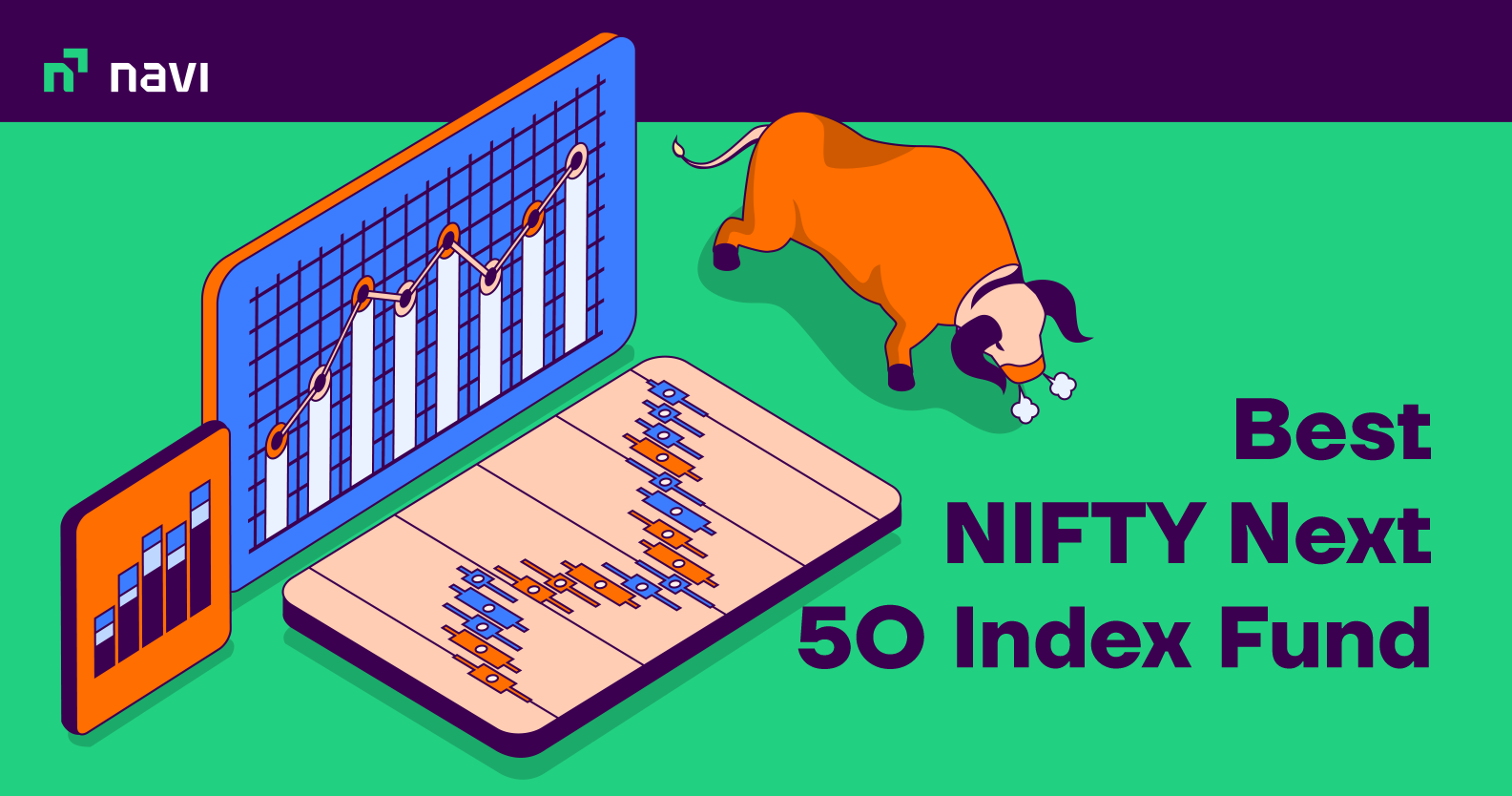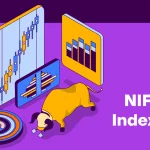10 Best Nifty Next 50 Index Funds in India in April 2023

What is the Nifty Next 50 index fund?
Nifty Next 50 index fund is a type of passively-managed equity fund that tracks the Nifty Next 50 index. The Nifty Next 50 index represents the performance of the next 50 company stocks that come after the Nifty 50 stocks; these stocks are listed based on total market capitalisation. These companies are generally potential candidates for inclusion in Nifty 50 in the future. Investing in Nifty Next 50 index funds could help you capture the growth of top Indian companies. We have listed 10 best Nifty Next 50 index funds that you could consider investing in.
Performance of Best Nifty Next 50 Index Funds in 2023
The Nifty Next 50 mutual fund list below highlights the NAV, AUM, and expense ratio of the funds.
| Nifty Next 50 Index Funds | Features |
| Navi Nifty Next 50 Index Fund | NAV: ₹8.74 AUM: ₹95.61 Crore Expense Ratio: 0.12% |
| Aditya Birla Sun Life Nifty Next 50 Index Fund | NAV: ₹9.16 AUM: ₹34.68 Crore Expense Ratio: 0.35% |
| Axis Nifty Next 50 Index Fund | NAV: ₹9.10 AUM: ₹78.34 Crore Expense Ratio: 0.23% |
| DSP Nifty Next 50 Index Fund | NAV: ₹14.5 AUM: ₹244.48 Crore Expense Ratio: 0.3% |
| Edelweiss Nifty Next 50 Index Fund | NAV: ₹8.54 AUM: ₹17.91 Crore Expense Ratio: 0.22% |
| HDFC NIFTY Next 50 Index Fund | NAV: ₹8.72 AUM: ₹372.02 Crore Expense Ratio: 0.3% |
| HSBC Nifty Next 50 Index Fund Direct | NAV: ₹16.20 AUM: ₹62.25 Crore Expense Ratio: 0.35% |
| ICICI Prudential Nifty Next 50 Index | NAV: ₹35.20 AUM: ₹2585.12 Crore Expense Ratio: 0.3% |
| Kotak Nifty Next 50 Index Fund | NAV: ₹10.72 AUM: ₹102.6 Crore Expense Ratio: 0.31% |
| Nippon India Nifty Next 50 Junior BeES FoF | NAV: ₹13.82 AUM: ₹163.12 Crore Expense Ratio: 0.02% |
Disclaimer: Mutual fund investments are subject to market risks, read all offer documents carefully.
Also Read
Detailed Overview of Best Nifty Next 50 Index Funds
1. Navi Nifty Next 50
Considered as one of the best Nifty Next 50 schemes due to its potential, the Navi Nifty Next 50 Index Fund provides exposure to tomorrow’s Nifty 50 Companies. Whenever new companies graduate to Nifty 50, they are usually selected from the Nifty Next 50 portfolio. In the last 19 years, out of the 75 stocks included in the Nifty 50 Index, 51 stocks have been from the Nifty Next 50 Index.
- NAV: ₹8.74
- AUM: ₹95.61 Crore
- Expense Ratio: 0.12%
- Min Investment
- SIP: ₹10
- Lump sum: ₹10
- Returns
- 6 months: 15.8% (absolute)
- 1 Year Return: NA
- Risk: Very high
2. Aditya Birla Sun Life Nifty Next 50 Index Fund – Direct Plan – Growth
It is a large cap mutual fund scheme launched on 31st Jan 2022 by Aditya Birla Sun Life Mutual Fund. The majority of the money in the fund is invested in others, consumer staples, energy, financial among a total of 10 sectors. The current top five holdings of the fund are LTIMindtree Ltd., Vedanta Ltd., Tata Power Company, Pidilite Industries and Godrej Consumer Products.
- NAV: ₹9.16
- AUM: ₹34.68 Crore
- Expense Ratio: 0.35%
- Min Investment
- SIP: ₹105
- Lumpsum: ₹105
- Returns
- 6 months: 15.4% (absolute)
- 3 Year Return: NA
- 5 Year Return: NA
- Risk: Very high
3. Axis Nifty Next 50 Index Fund – Direct Plan – Growth
It is a mutual fund scheme from Axis Mutual Fund launched on 7 Jan 2022. The sectoral allocation of the fund is completely in line with that of the Nifty Next 50 index. The current top five holdings of the fund are LTIMindtree Ltd., Vedanta Ltd., Tata Power Company, Pidilite Industries Ltd., and Godrej Consumer Products. Even though it is a relatively new fund, it has found a place in the best Nifty Next 50 mutual fund list due to its potential.
- NAV: ₹9.10
- AUM: ₹78.34 Crore
- Expense Ratio: 0.23%
- Min Investment
- SIP: ₹1000
- Lumpsum: ₹5000
- Returns
- 1 Year Return: NA
- 3 Year Return: NA
- 5 Year Return: NA
- Risk: Very high
4. DSP Nifty Next 50 Index Fund – Direct Plan – Growth
It is a large-cap mutual fund scheme from DSP Mutual Fund. Since its launch on 11 Feb 2019, it has delivered annual returns at an average of 9.7%.
- NAV: ₹14.5
- AUM: ₹244.48 Crore
- Expense Ratio: 0.30%
- Min Investment
- SIP: ₹500
- Lumpsum: ₹500
- Returns
- 1-Year Annualised Return: -5.4%
- 3-Year Annualised Return: 10.9%
- 5-Year Annualised Return: NA
- Risk: Very high
5. Edelweiss Nifty Next 50 Index Fund – Direct Plan – Growth
The Edelweiss Nifty Next 50 Index Fund is a relatively new scheme that was launched on 1 Dec 2022. It is an index with investments currently in LTIMindtree Ltd. and Vedanta Ltd., among others. It ranks among the top nifty next 50 index funds.
- NAV: ₹8.54
- AUM: ₹17.91 crore
- Expense Ratio: 0.22%
- Min Investment
- SIP: Rs. 500
- Lumpsum: Rs. 5000
- Returns
- 1 month: NA
- 3 Year Return: NA
- 5 Year Return: NA
- Risk: Very high
6. HDFC NIFTY Next 50 Index Fund – Direct Plan – Growth
It is a large-cap mutual fund scheme launched on 22 Oct 2021. The majority of the money in the fund is invested in energy, consumer staples, capital goods, and financial sectors. The top five holdings of the fund are listed in Adani Gas Ltd., LTIMindtree Ltd., Pidilite Industries Ltd., Bharat Electronics Ltd., and Ambuja Cements Ltd.
- NAV: ₹8.72
- AUM: ₹372.02 crore
- Expense Ratio: 0.3%
- Min Investment
- SIP: ₹100
- Lumpsum: ₹100
- Returns
- 1-Year Absolute Return: 1.3%
- 3 Year Return: NA
- 5 Year Return: NA
- Risk: Very high
7. HSBC Nifty Next 50 Index Fund Direct – Direct Plan – Growth
It is a large-cap mutual fund scheme from HSBC Mutual Fund launched on 24 March 2020. The majority of the money in the fund is invested in energy, consumer staples, capital goods, and financial sectors. The current top five holdings of the fund are LTIMindtree Ltd., Vedanta Ltd., Tata Power Company, Pidilite Industries Ltd., and Godrej Consumer Products.
- NAV: ₹16.20
- AUM: ₹62.25 crore
- Expense Ratio: 0.35% as on Dec 31, 2022
- Min Investment
- SIP: ₹500
- Lumpsum: ₹5000
- Returns
- 1 Year Absolute Return: 1.1%
- 3 Year Return: NA
- 5 Year Return: NA
- Risk: Very high
8. ICICI Prudential Nifty Next 50 Index – Direct Plan – Growth
It is a large-cap mutual fund scheme from ICICI Prudential Mutual Fund and one of the largest in terms of fund size in its category. Since its launch on 1 Jan 2013, the fund has delivered average annual returns at the rate of 11.8%. The majority of the money in the fund is invested in energy, consumer staples, capital goods, and financial sectors. The current top five holdings of the fund are LTIMindtree Ltd., Vedanta Ltd., Tata Power Company, Pidilite Industries Ltd., and Godrej Consumer Products.
- NAV: ₹34.20
- AUM: ₹2585.12 crore
- Expense Ratio: 0.3% as on Dec 31, 2022
- Min Investment
- SIP: ₹105
- Lumpsum: ₹105
- Returns
- 1-Year Annualised Return: -5.6%
- 3-Year Annualised Return: 10.9%
- 5-Year Annualised Return: 5.0%
- Risk: Very high
9. Kotak Nifty Next 50 Index Fund – Direct Plan – Growth
It is a large-cap index mutual fund scheme from Kotak Mahindra Mutual Fund. The majority of the money in the fund is invested in energy, consumer staples, capital goods, and financial sectors. The current top five holdings of the fund are LTIMindtree Ltd., Vedanta Ltd., Tata Power Company, Pidilite Industries Ltd., and Godrej Consumer Products.
- NAV: ₹10.72
- AUM: ₹102.6 crore
- Expense Ratio: 0.31%
- Min Investment
- SIP: ₹1000
- Lumpsum: ₹5000
- Returns
- 1 Year Return: 2.2% (absolute)
- 3 Year Return: NA
- 5 Year Return: NA
- Risk: Very high
10. Nippon India Nifty Next 50 Junior BeES FoF – Direct Plan – Growth
It is a large-cap mutual fund scheme from Nippon India Mutual Fund that tracks the Nifty Next 50 index. The current top five holdings of the fund are LTIMindtree Ltd., Vedanta Ltd., Tata Power Company, Pidilite Industries Ltd., and Godrej Consumer Products.
- NAV: ₹13.82
- AUM: ₹163.12 crore
- Expense Ratio: 0.02% as on Dec 31, 2022
- Min Investment
- SIP: ₹500
- Lumpsum: ₹105
- Returns
- 1-Year Annualised Return: -5.5%
- 3-Year Annualised Return: 11.0%
- 5-Year Annualised Return: NA
- Risk: Very high
*Data taken from respective AMC websites on Feb 28, 2023. Sata for illustrative purposes only. Past performance is no guarantee of future returns.
Disclaimer: Mutual fund investments are subject to market risks, read all offer documents carefully.
How is the Nifty Next 50 Index Constructed?
As mentioned above, the Nifty Next 50 represents the next 50 companies after the top 50 companies listed on the Nifty 100. The Nifty 100 Index is the index of the 100 largest Indian companies by full market capitalisation in the National Stock Exchange. Thus, the Nifty Next 50 Index represents the weighted average of companies ranging from 51st to 100th position.
These top nifty next 50 index funds are ranked by free-float market capitalisation forming part of the Nifty 100 Index. The index represents almost 10% of the free float market capitalisation of the stocks listed on the NSE as on March 29, 2019.
What is the Composition of the Nifty Next 50 Index?
Refer to the table below to understand Nifty Next 50 sector-wise structure along with weightage:
| Sector | Weight |
| Financial Services | 17.83% |
| Fast Moving Consumer Goods | 13.01% |
| Chemicals | 8.42% |
| Consumer Services | 7.91% |
| Oil, Gas & Consumable Fuels | 7.63% |
| Capital Goods | 7.57% |
| Construction Materials | 7.16% |
| Power | 7.08% |
| Information Technology | 5.32% |
| Consumer Durables | 3.99% |
| Metals and Mining | 3.45% |
| Automobile and Auto Components | 2.69% |
| Healthcare | 2.58% |
| Services | 2.13% |
| Realty | 2.05% |
| Telecommunication | 1.19% |
How to Invest in Nifty Next 50 Index Funds?
Online Process
You can directly invest in the top Nifty Next 50 index funds through AMC’s (Asset Management Company) website or a mobile app.
1. Investing through AMC’s Website
Step 1: Visit the official website of the AMC
Step 2: Fill in the required details
Step 3: Provide your Aadhaar card and PAN card details and complete the e-KYC
2. Investing through a Mobile Application
Step 1: Download the app
Step 2: Provide your contact details to register
Step 3: Complete the e-KYC process
Once your application is verified and approved, you can start investing in the best nifty next 50 mutual funds.
Offline Process
Alternatively, you can also invest in Nifty Next 50 index funds offline – here’s the step-by-step process:
Step 1: Contact a representative of the fund house or an empaneled distributor.
Step 2: Procure application and KYC form (if KYC procedure not completed) from the fund house’s website.
Step 3: Fill the application/KYC (if applicable) form, provide necessary information i.e. name, address, PAN, email address, mobile number, etc. This email address and mobile number will be used for further communication, and can also be used to register for online transaction services.
Step 4: Attach copies of relevant documents and submit them along with a cheque or demand draft of the desired investment amount.
Step 5: Submit duly signed application/KYC (if applicable) form(s), with the cheque and all relevant documents, to any branch of the fund house or point of acceptance.
Step 6: The fund house will then allocate and provide you a folio number for that particular investment. You will also receive an Account Statement, after the transaction is processed.
However, offline applications could be extremely time consuming. The better alternative is to invest online.
Also Read
Who Should Invest in Nifty Next 50 Index Funds?
Investing in Nifty Next 50 index fund is ideal for:
1. Beginner Investors
Nifty Next 50 index funds offer a simple and cost-effective way for beginner mutual fund investors who seek to gain exposure to equities without having to actively manage their portfolio.
2. Investors with a Long-term Investment Horizon
The true potential of Nifty Next 50 index funds is realised if you stay invested for the long-term. These funds are best suited for individuals who have a long-term investment horizon and are looking to build wealth over time.
3. Investors Looking to Invest in Top Companies at a Lower Risk
Nifty Next 50 index funds mirror the performance of the Nifty Next 50 index, which comprises the next 50 company stocks right after Nifty 50. Since these companies have significant potential to get featured in Nifty 50, they can offer risk-adjusted returns for the long term.
4. Investors Looking for Low-cost Investments
Nifty Next 50 index funds are passively-managed. There’s little cost regarding fund management. This significantly reduces the expense ratio, which in turn reduces the overall cost of the fund. This makes these funds a low-cost investment option.
5. Investors Seeking Diversification
These funds give investors exposure to top companies from diverse sectors. This diversification significantly helps in mitigating market-based risks.
Factors to Consider Before Investing in Nifty Next 50 Index Fund
Consider the following factors before investing in the best Nifty Next 50 index fund:
1. Investment Goals
Determine your financial goals and the time frame in which you hope to achieve them. This will help determine the type of index fund that aligns with your objectives.
2. Diversification
Assess the level of diversification you want in your portfolio. Index funds typically offer broad market exposure, but some funds may be more concentrated in certain sectors.
3. Expense Ratio
Consider the expense ratio, which is the annual fee charged by the fund to cover its operating costs. Lower expense ratios can result in higher returns over time.
4. Tracking Error
Consider the tracking error, which measures how closely the fund follows its underlying index. A higher tracking error may indicate that the fund is not accurately tracking its index, potentially affecting your returns..
Taxation on Nifty Next 50 Index Funds
Since index funds are a class of equity funds, these are taxed like other equity fund plans. The dividends offered by index funds are added to your overall income and taxed at the current income tax slab rate. The taxation rate on the capital gains that you make, however, depends on the holding period.
- Short-term capital gains (STCG): Gains on more than Rs.1 lakh for units held for less than 12 months are taxed at a rate of 15%
- Long-term Capital Gains (LTCG): Long-term gains are taxed at 10%. Long-term gains of up to Rs.1 lakh a year are exempt from tax.
Final Word
The Nifty Next 50 index fund offers a diverse investment opportunity in the rapidly growing Indian market. By investing in the 50 companies that are part of the NIFTY Next 50 index, investors can potentially reap the benefits of long-term growth and stability. With its strong track record and professional management, the best Nifty Next 50 index fund is a suitable option for those looking to invest in the Indian stock market.Capture the growth potential of the next big companies and get easy access to Nifty Next 50 with Navi Mutual Fund. Start investing with Rs.10!
FAQs
You can buy the Nifty Next 50 Index Fund via AMC’s website or respective mobile application.
The top Nifty Next 50 index funds have delivered a 17.2% annualised return as compared to 12.2% of the Nifty 50. A substantial excess return of 5% per annum has been recorded.
The Nifty Next 50 Index represents the 50 companies from the Nifty 100 after excluding the first Nifty 50 companies.
Yes. You can invest in the Nifty Next 50 funds by way of SIPs at regular intervals (monthly, quarterly, etc.).
Nifty Next 50 are taxed like other equity fund plans. Short-term capital gains are taxed at 15%, and long-term capital gains are taxed at 10%. However, long-term gains of up to Rs.1 lakh are tax-exempt.
Like any other equity investments, investing in Nifty Next 50 is also prone to market movements. But since the index has large-cap companies, the risks are low compared to small cap and mid cap funds. Also, these risks could be mitigated if you stay invested for the long-term.
For most Nifty Next 50 index funds, the minimum SIP is Rs. 500. However, with Navi Mutual Fund, you can start investing with as low as Rs.10!

Customer’s Feedback
No comments found.10 Best Demat Accounts in India for Beginners in 2023
Creation of Demat accounts revolutionised the way trades were conducted at the stock exchanges. It... Read More »10 Best SIP Plans for 1000 Per Month in India 2023
Systematic Investment Plan (SIP) is an investment style or route with which you can invest a fixed ... Read More »How to Invest in Mutual Funds in India – Easy Steps
Mutual funds can be an excellent way to diversify your portfolio and gain exposure to a wide range ... Read More »20 Best Nifty 50 Index Funds in India to Invest in April 2023
What is the Nifty 50 Index Fund? Nifty 50 index funds are a type of passively-managed equi... Read More »Asset Management Company (AMC) – Types and Benefits
What is an Asset Management Company (AMC)? Asset Management Company or AMC is a financial ... Read More »10 Best Gold Mutual Funds to Invest in India (April 2023)
Gold Mutual Funds are funds that invest in gold and gold-related assets such as bullion, coin... Read More »20 Best Flexi Cap Mutual Funds to Invest in India 2023
Flexi-cap funds are mutual fund schemes that aim to invest in stocks of companies across market cap... Read More »Best SIP Plans for 15 years – Top 10 SIP Plans to Invest in India 2023
A systematic investment plan (SIP) could be a convenient mode or style of investing in mutual funds... Read More »10 Best SIP Plans for 1 year Investment in India 2023
There has been a massive surge in SIP or Systematic Investment Plan investors in recent years. As p... Read More »10 Best SIP Plan for 3 Years in India to Invest in 2023
SIP or Systematic Investment Plan helps bring investment discipline in an investor’s life. It’s... Read More »10 Best SIP Plan for 10 years India in 2023 – Returns and Performance
Ask any beginner mutual fund investor and most of them would tell you that their preferred mode of ... Read More »10 Best SIP Plans for 5 years in India to Invest in 2023
Systematic Investment Plan (SIP) could be an effective investment mode if you want to invest a fixe... Read More »Top 10 Chit Fund Schemes in India in 2023
Chit funds are one of the most popular return-generating saving schemes in India. It is a financial... Read More »10 Best Gold ETFs in India to Invest in April 2023
Gold ETFs or Gold Exchange Traded Funds are passively managed funds that track the price of physica... Read More »10 Best Demat Accounts in India for Beginners in 2023
Creation of Demat accounts revolutionised the way trades were conducted at the stock exchanges. It... Read More »20 Best Index Funds to Invest in India in April 2023
What is an Index Fund? An index fund is a type of mutual fund or exchange-traded fund (ETF) that... Read More »Best Arbitrage Mutual Funds to Invest in India in April 2023
Arbitrage funds are hybrid mutual fund schemes that aim to make low-risk profits by buying and sell... Read More »10 Best SIP Plans in India to Invest in April 2023
What is SIP? SIP or Systematic Investment Plan is a method of investing a fixed amount in ... Read More »10 Best Corporate Bond Funds in India to Invest in April 2023
Corporate bond funds are debt funds that invest at least 80% of the investment corpus in companies ... Read More »10 Best Bank for Savings Account in India [Highest Interest Rate 2023]
Savings account is a type of financial instrument offered by several banks. It lets you safely depo... Read More »























